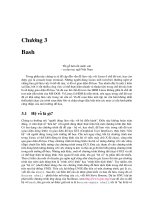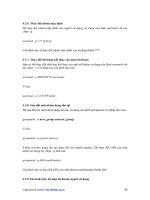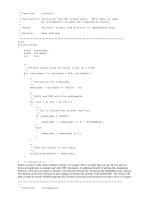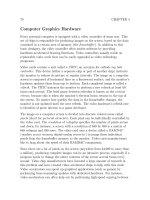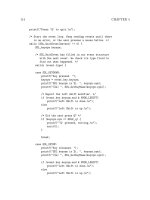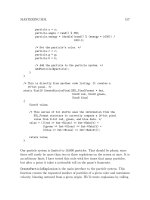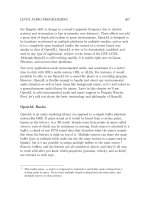Programming Linux Games phần 5 pps
Bạn đang xem bản rút gọn của tài liệu. Xem và tải ngay bản đầy đủ của tài liệu tại đây (261.07 KB, 50 trang )
MASTERING SDL 157
particle.y = y;
particle.angle = rand() % 360;
particle.energy = (double)(rand() % (energy * 1000)) /
1000.0;
/* Set the particle’s color. */
particle.r = r;
particle.g = g;
particle.b = b;
/* Add the particle to the particle system. */
AddParticle(&particle);
}
}
/* This is directly from another code listing. It creates a
16-bit pixel. */
static Uint16 CreateHicolorPixel(SDL_PixelFormat * fmt,
Uint8 red, Uint8 green,
Uint8 blue)
{
Uint16 value;
/* This series of bit shifts uses the information from the
SDL_Format structure to correctly compose a 16-bit pixel
value from 8-bit red, green, and blue data. */
value = (((red >> fmt->Rloss) << fmt->Rshift) +
((green >> fmt->Gloss) << fmt->Gshift) +
((blue >> fmt->Bloss) << fmt->Bshift));
return value;
}
Our particle system is limited to 10,000 particles. That should be plenty, since
there will rarely be more than two or three explosions on the screen at once. It is
an arbitrary limit; I have tested this code with five times that many particles,
but after a point it takes a noticeable toll on the game’s framerate.
CreateParticleExplosion is the main interface to the particle system. This
function creates the requested number of particles of a given color and maximum
velocity, blasting outward from a given origin. We’ll create explosions by calling
158 CHAPTER 4
CreateParticleExplosion several times, with different velocities and colors.
This will allow us to simulate a colorful explosion, with hotter particles closer to
the center of the blast. Remember that we care little about proper physics—it’s
been said that game programming is all about taking as many shortcuts as
possible without cheating the player of a good experience. If an explosion looks
good, it is good.
The other two important particle system routines are UpdateParticles and
DrawParticles. The former recalculates the position and color of each particle
and checks to see whether it should be removed from the system. Particles are
removed when they have faded to black and are therefore invisible (since the
backdrop is also mostly black). The latter draws a pixel for each currently
visible particle. Note that we use the CreateHicolorPixel routine from a
previous example and therefore commit to using a 16-bit framebuffer. It would
be fairly simple to modify this to work for 8- or 24-bit surfaces as well, but I
doubt it would be worth the effort.
Particle systems are amazingly versatile, and you could easily create custom
versions of CreateParticleExplosion to simulate various types of explosions.
The game Heavy Gear II uses dozens of different types of particle simulations for
everything from rain to smoke.
Game Timing
Try running our SDL animation examples on a computer with a slow video
system, and then on a computer with a cutting-edge accelerator supported by X.
You will notice a large speed difference between the two, and this disparity can
be a serious problem for games. While it is important to draw frames as quickly
as possible (30 to 60 per second, if possible), it is also important to make sure
that this does not give players with slow hardware an unfair advantage (since
speed often corresponds to difficulty).
You have two options for dealing with this disparity in performance: you can
lock the framerate at a certain value and simply refuse to run on machines that
can’t keep up, or you can measure the framerate and adjust the speed of the
game accordingly. Most games use the latter option, so as not to exclude gamers
with slow computers. It turns out that this is not terribly difficult to implement.
MASTERING SDL 159
Instead of specifying game object movement in pixels per frame, Penguin
Warrior uses pixels per unit of time (Just about any unit of time would work,
but we’ll use 1/30th of a second as our baseline, so that a performance of 30
frames per second will result in no adjustment to the game’s speed.) To calculate
how far each game object should move in a frame, we determine how much time
has passed since the last update and scale our movement accordingly. We update
a global time scale variable with this information at the start of each frame.
Each time we need to move an object, we scale the distance by this amount. We
also apply this scaling to acceleration and turning.
Take a look at the Penguin Warrior code to see how this is done. It’s not too
complicated, and it lets the game run at its highest performance on any
computer.
With the parallaxing code, the particle system, a timing mechanism, and a bit of
other SDL voodoo, we now have a working game engine, albeit a simple one. It
lacks sound, other players, and weaponry, but we’ll add these later on. It’s time
to take a break from SDL and Penguin Warrior for a tour of the slightly
maddening world of Linux audio.
Chapter 5
Linux Audio Programming
Hardware manufacturers are often reluctant to release programming
specifications to independent developers. This has impeded Linux’s development
at times and has resulted in less than optimal drivers for certain devices.
However, the recent explosion in Linux’s popularity has drawn attention to the
project, and hardware support has improved considerably of late. Most
consumer audio hardware is now fully supported under Linux, and some
manufacturers have even contributed their own open source drivers for their
hardware. This chapter discusses the ups and downs of Linux sound
programming with several important APIs.
If you haven’t yet read Chapter 4, it would be a good idea to flip back to its
basic explanation of sound samples, buffers, and frequencies (beginning on page
125). This chapter will assume that you are familiar with these basics, and we
won’t spend any more time on the subject.
This chapter describes the development of a complete Linux sound file player,
dubbed Multi-Play. In the course of developing this real-world application, we
will look at how to load sound data from disk and discuss four common methods
of playing sound under Linux. By the end of the chapter, you will know how to
integrate sound into a Linux game using any of the major APIs. The chapter
ends with a discussion of the OpenAL environmental audio library, which is very
useful for producing realistic sound effects in 3D environments.
162 CHAPTER 5
Competing APIs
Linux is home to two competing sets of sound drivers. While Linux skeptics are
likely to shout, “Aha! Fragmentation!” upon hearing this, the competition has
raised the bar and has resulted in a much higher-quality set of sound drivers.
Linux now supports almost every sound card on the market. One set of drivers is
very consistent, complete, and stable, while the other set frequently breaks
compatibility in order to cleanly integrate cutting-edge features. These two sets
are largely interoperable, and so Linux users can enjoy the best of both worlds.
The original Linux sound API is the Open Sound System (OSS). OSS consists of
a set of kernel modules that provide a common programming interface to
hundreds of different sound cards. Some of these modules (OSS/Free) are
distributed for free with the Linux kernel, and some are available in binary-only
form for a fee from 4Front Technologies
1
. The OSS modules are well written and
commercially supported, but the OSS programming interface leaves something to
be desired. Nonetheless, OSS is more or less a de facto standard for Linux audio,
and supporting OSS virtually guarantees that your application will work on
most sound hardware.
The Advanced Linux Sound Architecture (ALSA) project
2
has created an
alternate set of Linux sound drivers. ALSA consists of a set of kernel modules as
well as a programming library, providing support for a substantial and ever
increasing number of sound cards. The ALSA library is much more convenient
than the OSS’s ioctl-based interface, and there is a simple emulation driver to
support programs that don’t use the native ALSA API. Perhaps the most
significant difference between ALSA and OSS is that ALSA is a free software
project maintained by volunteers, whereas OSS is a commercial venture that can
support the latest hardware through nondisclosure agreements. Each approach
has advantages. ALSA’s biggest problem is that it is not quite ready to go
mainstream yet; its programming interface changes with every major release
(but this is slowing down). Many people use ALSA exclusively for its OSS
compatibility mode, since many applications don’t support ALSA directly.
1
2
LINUX AUDIO PROGRAMMING 163
With this brief comparison in mind, which sound interface should your games
use? ALSA is a bit more programmer-friendly, if you can tolerate its evolving
API. It has a well-designed (albeit changing) interface with lots of bells and
whistles. OSS currently has a wider base of users but a rather crude
programming interface. If providing support for both APIs is out of the
question, I recommend coding for OSS and then testing with the ALSA
emulation facility. An alternate approach would be to use a higher-level library
such as SDL or OpenAL that can work with either interface.
Introducing Multi-Play
Multi-Play is a simple command-line sound file player. It works with normal
OSS, OSS using direct DMA buffer access, ESD, and ALSA and supports a large
number of sound file formats. Since it is designed to clearly demonstrate audio
programming, Multi-Play lacks a few of the features one might find in an
end-user player program, such as support for nonstandard frequencies and
sample sizes. Feel free to use pieces of the Multi-Play code in your own projects
or even to develop the complete player into a finished product. It’s meant to be
a Rosetta stone of sorts, performing the same basic task (sound playback) in
several different ways.
Since Multi-Play is meant to demonstrate the mechanics of audio programming
(and is not really intended for day-to-day use), it doesn’t compensate for certain
types of “errors.” For instance, ESD does not properly handle 8-bit samples in
some cases, but Multi-Play will attempt to use them anyway (whereas an
end-user player might automatically change 8-bit samples into 16-bit samples for
ESD playback). It also blindly tries to set the driver to the sample rate indicated
by the sound file. This will not work in some cases, since drivers often don’t
support oddball sample rates. A high-quality sound player should try to
compensate for this problem. However, doing so shouldn’t be necessary for most
game development situations.
The complete code for Multi-Play is available on the Web site; it is excerpted as
appropriate here. It is a good idea to obtain and compile a copy of the code.
Experimentation is the best way to learn any new area of programming.
164 CHAPTER 5
Loading Sound Files
SDL provides a convenient SDL LoadWAV function, but it is of little use to
programs that don’t use SDL, and it reads only the wave (.wav) file format. A
better option is the libsndfile library maintained by Erik de Castro Lopo, which
contains routines for loading nearly every common sound format. This library is
easy to use, and it is available under the GNU LGPL (formerly the more
restrictive GPL). You might also consider Michael Pruett’s libaudiofile library, a
free implementation of an API originally developed by Silicon Graphics. It is a
bit less straightforward than libsndfile, however.
Using libsndfile
The libsndfile library makes it easy to read sample data from a large number of
sound file formats. Sound files in any supported format are opened with a single
library function, and individual samples can then be read with a common
interface, regardless of the file format’s encoding or compression. Your program
must still take the size and signedness of the sample data into account, but
libsndfile provides the necessary information.
The sf open read function opens a sound file for reading. This function accepts
a filename and a pointer to an SF INFO structure and returns a pointer to a
SNDFILE structure. The SF INFO structure represents the format of the sound
data: its sample rate, sample size, and signedness. sf open read fills in this
structure; your program does not need to supply this information in most cases.
The SNDFILE structure returned by sf open read is a file handle; its contents
are used internally by libsndfile, and they are not important to us. sf open read
returns NULL if the requested file cannot be opened. For the curious, libsndfile
does provide a sf open write facility for writing sound files, but this facility is
beyond our present needs.
After opening a sound file and obtaining a SNDFILE pointer, your program can
read samples from it. libsndfile provides functions for reading samples as short
integers, integers, or doubles. Each sample (8- or 16-bit) is called an item, and a
pair of stereo samples (or one mono sample) is a frame. libsndfile allows you to
read individual items or complete frames. The sf readf short, sf readf int,
and sf readf double functions read frames from a SNDFILE into buffers of
various types. sf readf double can optionally scale samples to the interval
LINUX AUDIO PROGRAMMING 165
[−1 1], which is convenient for advanced audio processing. We will demonstrate
this function in the next example.
When your program is finished reading sound data from a SNDFILE, it should
close the file with the sf close function.
Function sf open read(filename, info)
Synopsis Opens a sound file, such as a .wav or .au file, for
reading.
Returns Pointer to a SNDFILE structure that represents the
open file. Fills in the provided SF INFO structure with
information about the sound data.
Parameters filename—The name of the file to open.
info—Pointer to the SF INFO structure that should
receive information about the sound data.
Structure SF INFO
Synopsis Information about the data contained in a sound file.
Members samplerate—Sample rate of the sound data, in hertz.
samples—Number of samples contained in each
channel of the sound file. (The total number of
samples is channels * samples.)
channels—Number of channels contained in the sound
file. This is usually 1 for mono or 2 for stereo.
pcmbitwidth—Number of bits per sample.
format—Sample format. Format constants are defined
in sndfile.h. This chapter only uses a small portion of
libsndfile’s capabilities—it can understand a wide
variety of encoding formats, not just raw PCM.
166 CHAPTER 5
Function sf readf type (sndfile, buffer, frames)
Synopsis Reads PCM data from an open sound file and returns
it as a particular data type (regardless of the sample’s
original format). Possible types are short, int, and
double. The double version of this function takes an
extra boolean flag that indicates whether libsndfile
should normalize sample values to the range [−1 1].
Returns Number of frames successfully read.
Parameters sndfile—Pointer to an open SNDFILE handle.
buffer—Pointer to a buffer for the data.
frames—Number of frames to read. (A frame consists
of one sample from each channel.)
Function sf close(sndfile)
Synopsis Closes a sound file.
Parameters sndfile—Pointer to the SNDFILE to close.
Code Listing 5–1 (mp-loadsound.c)
/* Sound loader for Multi-Play. */
#include <stdio.h>
#include <stdlib.h>
#include <sndfile.h>
/* Loads a sound file from disk into a newly allocated buffer.
Sets *rate to the sample rate of the sound, *channels to the
number of channels (1 for mono, 2 for stereo), *bits to the
sample size in bits (8 or 16), *buf to the address of the
buffer, and *buflen to the length of the buffer in bytes.
16-bit samples will be stored using the host machine’s
endianness (little endian on Intel-based machines, big
endian on PowerPC, etc.)
LINUX AUDIO PROGRAMMING 167
8-bit samples will always be unsigned. 16-bit will always
be signed.
Channels are interleaved.
Requires libsndfile to be linked into the program.
Returns 0 on success and nonzero on failure. Prints an error
message on failure. */
int LoadSoundFile(char *filename, int *rate, int *channels,
int *bits, u_int8_t **buf, int *buflen)
{
SNDFILE *file;
SF_INFO file_info;
short *buffer_short = NULL;
u_int8_t *buffer_8 = NULL;
int16_t *buffer_16 = NULL;
int i;
/* Open the file and retrieve sample information. */
file = sf_open_read(filename, &file_info);
if (file == NULL) {
printf("Unable to open ’%s’.\n", filename);
return -1;
}
/* Make sure the format is acceptable. */
if ((file_info.format & 0x0F) != SF_FORMAT_PCM) {
printf("’%s’ is not a PCM-based audio file.\n",
filename);
sf_close(file);
return -1;
}
if ((file_info.pcmbitwidth != 8) &&
(file_info.pcmbitwidth != 16)) {
printf("’%s’ uses an unrecognized sample size.\n",
filename);
sf_close(file);
return -1;
}
168 CHAPTER 5
/* Allocate buffers. */
buffer_short = (short *)malloc(file_info.samples *
file_info.channels *
sizeof (short));
buffer_8 = (u_int8_t *)malloc(file_info.samples *
file_info.channels *
file_info.pcmbitwidth / 8);
buffer_16 = (int16_t *)buffer_8;
if (buffer_short == NULL || buffer_8 == NULL) {
printf("Unable to allocate enough memory for ’%s’.\n",
filename);
fclose(file);
free(buffer_short);
free(buffer_8);
return -1;
}
/* Read the entire sound file. */
if (sf_readf_short(file,buffer_short,file_info.samples) ==
(size_t)-1) {
printf("Error while reading samples from ’%s’.\n",
filename);
fclose(file);
free(buffer_short);
free(buffer_8);
return -1;
}
/* Convert the data to the correct format. */
for (i = 0; i < file_info.samples * file_info.channels; i++) {
if (file_info.pcmbitwidth == 8) {
/* Convert the sample from a signed short to an
unsigned byte */
buffer_8[i] = (u_int8_t)((short)buffer_short[i] + 128);
} else {
buffer_16[i] = (int16_t)buffer_short[i];
}
}
LINUX AUDIO PROGRAMMING 169
/* Return the sound data. */
*rate = file_info.samplerate;
*channels = file_info.channels;
*bits = file_info.pcmbitwidth;
*buf = buffer_8;
*buflen = file_info.samples * file_info.channels *
file_info.pcmbitwidth / 8;
/* Close the file and return success. */
sf_close(file);
free(buffer_short);
return 0;
}
This routine serves as Multi-Play’s file loader. It begins by opening a sound file
with sf
open, checking that the samples are in plain PCM format (libsndfile
does support other sample types), and verifying that the samples are either 8-bit
or 16-bit (again, other sample types are possible but less common). It then
allocates memory for the samples. Since the size of short integers can vary from
platform to platform, this routine takes a safe approach of allocating a
temporary buffer of type short for loading the file and then copying the samples
to a buffer of either int16 t or u int8 t. This is a bit wasteful, and a
production-quality sound player should probably take a different approach (such
as using sizeof to determine the size of short and handling particular cases).
With the sample data now in memory, the routine passes the relevant data back
to its caller and returns zero.
libsndfile treats all PCM samples as signed and reads them as short, int, or
double. The actual number of bits used by each sample is indicated in the
pcmbitwidth field of the SF INFO structure. Since our sound player will treat all
8-bit samples as unsigned and all 16-bit samples as signed (the usual convention
for sound playback), our loader converts 8-bit samples to unsigned by adding 128
(bringing them into the range [0 255]). Sixteen-bit samples need no special
handling, since libsndfile returns samples in the host machine’s endianness (little
endian on Intel-based machines and big endian on many others).
170 CHAPTER 5
Other Options
If for some reason libsndfile doesn’t appeal to you, there are several other
options. You could use the libaudiofile library, which has a slightly different API
and similar capabilities. libaudiofile has been around for a long time, and it is
widely used. You could implement your own wave file loader, but this is extra
work. The original wave file format has a very simple structure, consisting of
little more than a RIFF header and a block of raw sample data. Unfortunately,
some wave files are encoded in strange ways, and these must be either
specifically handled or rejected. Libraries such as libsndfile and libaudiofile
handle these quirks automatically.
Another option is to convert your sound files into a simpler format that is trivial
to load. The SoX (Sound eXchange) utility is handy for this purpose. SoX can
rewrite sound files as raw, headerless data, which you can then load with the C
library’s fopen and fread functions. The main drawbacks to this approach are
that the sound will be completely uncompressed (assuming that it was
compressed to begin with) and that you will have to keep track of the sound’s
sample format by hand. This is a general nuisance, and so it’s better to use a
library for loading sound files.
Using OSS
The OSS API is based on device files and the ioctl facility. UNIX device files
are files that represent devices in the system rather than ordinary data storage
space. To use a device file, an application typically opens it by name with the C
library’s open function and then proceeds to exchange data with it using the
standard read and write functions. The kernel recognizes the file as a device
and intercepts the data. In the instance of a sound card, this data would consist
of raw PCM samples. Device files are traditionally located in the /dev directory
on UNIX systems, but they can technically exist anywhere in the filesystem. The
main OSS device files are /dev/dsp and /dev/audio.
This explains how a program can get samples into the sound card, but what
about the sound card’s other attributes, such as the sample format and sampling
rate? This is where ioctl comes in. The ioctl function (a system call, just like
read or write) allows you to send special commands to device files, usually to
LINUX AUDIO PROGRAMMING 171
configure the device before sending data with write. ioctl is a low-level
interface, but there is really nothing difficult about it, so long as you have plenty
of documentation about the device file you are working with (hence this book).
OSS provides a header file (soundcard.h) with symbols for the various ioctl
calls it supports. Be careful with ioctl; its data goes directly to the kernel, and
you could possibly throw a wrench into the system by sending unexpected data
(though this would be considered a bug in the kernel; if you find such a bug,
please report it).
Before we discuss ways to improve OSS’s performance for gaming, let’s examine
the code for Multi-Play’s OSS back end.
Code Listing 5–2 (mp-oss.c)
/* Basic sound playback with OSS. */
#include <stdio.h>
#include <unistd.h>
#include <fcntl.h>
#include <sys/ioctl.h>
#include <sys/soundcard.h>
#include <sys/mman.h>
/* Plays a sound with OSS (/dev/dsp), using default options.
samples - raw 8-bit unsigned or 16-bit signed sample data
bits - 8 or 16, indicating the sample size
channels - 1 or 2, indicating mono or stereo
rate - sample frequency
bytes - length of sound data in bytes
Returns 0 on successful playback, nonzero on error. */
int PlayerOSS(u_int8_t *samples, int bits, int channels,
int rate, int bytes)
{
/* file handle for /dev/dsp */
int dsp = 0;
/* Variables for ioctl’s. */
unsigned int requested, ioctl_format;
unsigned int ioctl_channels, ioctl_rate;
172 CHAPTER 5
/* Playback status variables. */
int position;
/* Attempt to open /dev/dsp for playback (writing). */
dsp = open("/dev/dsp",O_WRONLY);
/* This could very easily fail, so we must handle errors. */
if (dsp == -1) {
perror("OSS player: error opening /dev/dsp for playback");
return -1;
}
/* Select the appropriate sample format. */
switch (bits) {
case 8: ioctl_format = AFMT_U8; break;
case 16: ioctl_format = AFMT_S16_NE; break;
default: printf("OSS player: unknown sample size.\n");
return -1;
}
/* We’ve decided on a format. We now need to pass it to OSS.
ioctl is a very generalized interface. We always pass data
to it by reference, not by value, even if the data is a
simple integer. */
requested = ioctl_format;
if (ioctl(dsp,SNDCTL_DSP_SETFMT,&ioctl_format) == -1) {
perror("OSS player: format selection failed");
close(dsp);
return -1;
}
/* ioctl’s usually modify their arguments. SNDCTL_DSP_SETFMT
sets its integer argument to the sample format that OSS
actually gave us. This could be different than what we
requested. For simplicity, we will not handle this
situation. */
if (requested != ioctl_format) {
printf("OSS player: unsupported sample format.\n");
close(dsp);
return -1;
}
LINUX AUDIO PROGRAMMING 173
/* We must inform OSS of the number of channels
(mono or stereo) before we set the sample rate. This is
due to limitations in some (older) sound cards. */
ioctl_channels = channels;
if (ioctl(dsp,SNDCTL_DSP_CHANNELS,&ioctl_channels) == -1) {
perror("OSS player: unable to set the number of channels");
close(dsp);
return -1;
}
/* OSS might not have granted our request, even if the ioctl
succeeded. */
if (channels != ioctl_channels) {
printf("OSS player: unable to set the number of channels.\n");
close(dsp);
return -1;
}
/* We can now set the sample rate. */
ioctl_rate = rate;
if (ioctl(dsp,SNDCTL_DSP_SPEED,&ioctl_rate) == -1) {
perror("OSS player: unable to set sample rate");
close(dsp);
return -1;
}
/* OSS sets the SNDCTL_DSP_SPEED argument to the actual
sample rate, which may be different from the requested rate.
In this case, a production-quality player would upsample or
downsample the sound data. We’ll simply report an error. */
if (rate != ioctl_rate) {
printf("OSS player: unable to set the sample rate.\n");
close(dsp);
return -1;
}
/* Feed the sound data to OSS. */
position = 0;
while (position < bytes) {
int written, blocksize;
174 CHAPTER 5
/* We’ll send audio data in 4096-byte chunks.
This is arbitrary, but it should be a power
of two if possible. This conditional just makes
sure we properly handle the last chunk in the
buffer. */
if (bytes-position < 4096)
blocksize = bytes-position;
else
blocksize = 4096;
/* Write to the sound device. */
written = write(dsp,&samples[position],blocksize);
if (written == -1) {
perror("\nOSS player: error writing to sound device");
close(dsp);
return -1;
}
/* Update the position. */
position += written;
/* Print some information. */
WritePlaybackStatus(position, bytes, channels, bits, rate);
printf("\r");
fflush(stdout);
}
printf("\n");
close(dsp);
return 0;
}
This is the first of five Multi-Play player back ends, and one of three relating to
OSS. These players are self-contained and handle all necessary initialization and
cleanup internally. Their parameters are self-explanatory: the sound buffer to
play is passed as a u int8 t pointer, and various information about the sample
format and playback rate is passed in as integers.
Our player begins by opening the /dev/dsp device file. A production-quality
player would likely provide some sort of command-line option to specify a
LINUX AUDIO PROGRAMMING 175
different OSS device, but /dev/dsp is valid on most systems. If the file is
opened successfully, the player begins to set the appropriate playback parameters
with the ioctl interface.
The first step in configuring the driver is to set the sample size. Our loader
recognizes both 8-bit unsigned and 16-bit signed samples, and these are the only
cases our player needs to account for. After selecting the appropriate constant
(codeAFMT S16 NE for 16-bit signed with default endianness, or AFMT U8 for
8-bit unsigned), it calls ioctl with SNDCTL DSP SETFMT. This ioctl call could
fail if the driver does not support the requested format, but this is unlikely to
happen unless the user has an extremely old sound card. We could instead use
AFMT S16 LE or AFMT S16 BE to explicitly set little or big endianness,
respectively. If this ioctl succeeds, the player sets the number of channels and
the sample rate in a similar fashion. It is important to set the number of
channels before the sample rate, because some sound cards have different
limitations in mono or stereo mode.
The sound driver is now configured, and our player can begin sending samples to
the device. Our player uses the standard UNIX write function to transfer the
samples in 4,096-byte increments. Since sound cards play samples at a limited
rate (specified by the sampling frequency), it is possible that these write calls
will block (delay until the sound card is ready for more samples) and thereby
limit the speed of the rest of the program. This would not be acceptable in a
game, since games typically have better things to do than wait on the sound
card. We will discuss ways to avoid blocking in the next section.
When the entire set of samples has been transferred to the sound card, our
player closes the /dev/dsp device and returns zero.
Reality Check
The OSS Web site has two main documents about OSS programming: Audio
Programming and Making Audio Complicated. The former describes the basic
method of OSS programming and is fairly simple to understand. The latter is
aptly named; sound programming can quickly devolve into a messy subject. We
will now cover some of the ugly details that are necessary for real-world game
development. Unfortunately, the simple example we just discussed is woefully
inadequate.
176 CHAPTER 5
Perhaps the stickiest issue in game sound programming (particularly with OSS)
is keeping the sound playback stream synchronized with the rest of the game.
SDL provided a nice callback that would notify your program whenever the
sound card was hungry for more samples, but OSS doesn’t have a callback
system. If you try to write too many samples before the card has a chance to
play them, the write function will block (that is, it will not return until it can
complete). As a result, the timing of your entire program will depend on OSS’s
playback speed. This is not good.
A closely related issue is latency. It is inevitable that a game’s sound will lag
slightly behind the action on the screen; all games experience this, and it is not a
problem so long as the latency is only a small fraction of a second (preferably
under
1
10
second). Unfortunately, OSS has quite a bit of internal buffer space,
and if you were to fill it to capacity by blindly calling write, your latency would
go through the roof. Imagine playing Quake and hearing a gunshot sound several
seconds after firing the gun—you would probably laugh and switch to a different
game!
OSS stores samples in an internal buffer that is divided into fragments of equal
size. Each fragment stores approximately
1
2
second of audio data (resulting in a
potential latency of
1
2
second). When the sound card is finished playing a
fragment, it jumps to the next. If the next fragment has not been filled with
samples, the sound card will play whatever happens to be there, which results in
audio glitches. Ideally, you want to stay just a few fragments ahead of the sound
card, to avoid skipping while keeping latency to a minimum. You can, within
limits, specify the number of fragments and the size of each.
To set OSS’s internal fragment size, send the SNDCTL DSP SETFRAGMENT ioctl
with a bitfield-encoded argument:
int ioctl_frag;
/* Set the fragment parameters. See the text for an explanation. */
ioctl_frag = 10; /* fragment size is 2^10 = 1024 bytes */
ioctl_frag += 3 * 65536; /* fragment count is 3 */
if (ioctl(dsp,SNDCTL_DSP_SETFRAGMENT,&ioctl_frag) != 0) {
/* handle error */
}
LINUX AUDIO PROGRAMMING 177
This ioctl should be called as soon as possible after opening the audio device; it
will not work after the first write call has been made, and it might not work
after other settings have been applied. Its unsigned integer argument is divided
into two bit fields. The lower 16 bits specify the fragment size as a power of 2.
For instance, a value of 10 in the lower 16 bits requests a fragment size of 2
10
, or
1,024 bytes. The high 16 bits of the argument specify the number of fragments
to allocate. In this case we request only three fragments, meaning that we will
have to be fairly attentive to the audio device if we want to avoid glitches.
Our next task is to get rid of the blocking write call. We can use OSS’s buffer
information ioctl to avoid blocking:
for (;;) {
audio_buf_info info;
/* Ask OSS if there is any free space in the buffer. */
if (ioctl(dsp,SNDCTL_DSP_GETOSPACE,&info) != 0) {
perror("Unable to query buffer space");
close(dsp);
return 1;
}
/* Any empty fragments? */
if (info.fragments > 0) break;
/* Not enough free space in the buffer. Waste time. */
usleep(100);
}
This addition to the main player loop (right before the actual write call) simply
queries OSS to check for an empty fragment. If at least one fragment is
available, we can safely write a chunk of sample data without blocking. If there
is no space in the outgoing sound buffer, we kill time with the usleep function.
A game would probably use this time to do something productive, such as
updating the video display. We use the SNDCTL DSP GETOSPACE ioctl to check
for the availability of a fragment. This ioctl returns a structure (defined in
soundcard.h) with various statistics about OSS’s internal buffers.
178 CHAPTER 5
Warning
Generally speaking, minor tweaks to OSS parameters (such as setting a
custom fragment size) are safe; they are unlikely to break compatibility
with most drivers or even ALSA’s OSS emulator. I used a laptop with
the ALSA sound driver to create these code examples. ALSA’s OSS
emulation is less than perfect, and the examples worked slightly
differently under ALSA and OSS. It is important to test audio code on
as many systems as possible and with both ALSA and OSS. Audio
programming involves a lot of fine-tuning; in a world with thousands of
different audio cards, it is far from a precise science.
Achieving Higher Performance with Direct DMA Buffer Access
Sometimes OSS’s basic mechanism of writing samples to the sound device does
not provide sufficient performance. OSS provides an alternative, but it is neither
pretty nor simple. It is possible to use the UNIX mmap function to gain direct
access to the sound driver’s DMA buffer. The DMA buffer is a region of memory
that the sound system’s hardware scans for samples at regular intervals; it is the
audio equivalent of the raw video framebuffer. If your program can somehow
gain access to the DMA buffer, it can mix and send its own fragments directly to
the sound card, without any driver intervention. Latency is still a concern, but
this technique bypasses the driver’s internal buffering and therefore gives you the
power to push latency as close to the line as you wish (at the risk of skipping or
other anomalies).
Direct DMA buffer access is absolutely not portable. It is known to be
incompatible with certain configurations (including my laptop, much to my
chagrin), but it will probably work on most Linux-based systems with “normal”
sound hardware. This particular example did work on my FreeBSD 4.1 system,
but with a noticeable choppiness. So far it has worked on one of my Linux
systems. We recommend avoiding this technique if possible, or at least providing
a “safe” alternative in case DMA initialization fails. Have you ever been
frustrated that an OSS application (such as Quake 3) would not work with the
ALSA or ESD emulation drivers? Direct DMA access was likely the cause.
However, these applications do enjoy improved audio performance with less CPU
usage.
LINUX AUDIO PROGRAMMING 179
The next player back end accesses the DMA buffer directly. It uses the basic
technique presented in 4Front Technologies’ original mmap test.c example, but
with a slightly different buffering scheme in the main loop. This player back end
has been tested successfully on a number of sound cards, but it is not compatible
with ALSA’s OSS emulation driver.
Code Listing 5–3 (mp-dma.c)
/* DMA sound playback with OSS. */
#include <stdio.h>
#include <unistd.h>
#include <fcntl.h>
#include <sys/ioctl.h>
#include <sys/soundcard.h>
#include <sys/mman.h>
/* Plays a sound with OSS (/dev/dsp), using direct DMA access.
Returns 0 on successful playback, nonzero on error. */
int PlayerDMA(u_int8_t *samples, int bits,
int channels, int rate, int bytes)
{
/* file handle for /dev/dsp */
int dsp = 0;
/* Variables for ioctl’s. */
unsigned int requested, ioctl_format, ioctl_channels,
ioctl_rate, ioctl_caps, ioctl_enable;
audio_buf_info ioctl_info;
/* Buffer information. */
int frag_count, frag_size;
u_int8_t *dmabuffer = NULL;
int dmabuffer_size = 0;
int dmabuffer_flag = 0;
/* Playback status variables. */
int position = 0, done = 0;
180 CHAPTER 5
/* Attempt to open /dev/dsp for playback. We need to open for
read/write in order to mmap() the device file. */
dsp = open("/dev/dsp",O_RDWR);
/* This could very easily fail, so we must handle errors. */
if (dsp < 0) {
perror("DMA player: error opening /dev/dsp for playback");
goto error;
}
/* Select the appropriate sample format. */
switch (bits) {
case 8: ioctl_format = AFMT_U8; break;
case 16: ioctl_format = AFMT_S16_NE; break;
default: printf("DMA player: unknown sample size.\n");
goto error;
}
/* We’ve decided on a format. We now need to pass it to OSS. */
requested = ioctl_format;
if (ioctl(dsp,SNDCTL_DSP_SETFMT,&ioctl_format) == -1) {
perror("DMA player: format selection failed");
goto error;
}
/* ioctl’s usually modify their arguments. SNDCTL_DSP_SETFMT
sets its integer argument to the sample format that OSS
actually gave us. This could be different than what we
requested. For simplicity, we will not handle this
situation. */
if (requested != ioctl_format) {
printf("DMA player: unsupported sample format.\n");
goto error;
}
/* We must inform OSS of the number of channels (mono or stereo)
before we set the sample rate. This is due to limitations in
some (older) sound cards. */
ioctl_channels = channels;
if (ioctl(dsp,SNDCTL_DSP_CHANNELS,&ioctl_channels) == -1) {
perror("DMA player: unable to set the number of channels");
goto error;
LINUX AUDIO PROGRAMMING 181
}
/* OSS might not have granted our request, even if the ioctl
succeeded. */
if (channels != ioctl_channels) {
printf("DMA player: unable to set the number of channels.\n");
goto error;
}
/* We can now set the sample rate. */
ioctl_rate = rate;
if (ioctl(dsp,SNDCTL_DSP_SPEED,&ioctl_rate) == -1) {
perror("DMA player: unable to set sample rate");
goto error;
}
/* OSS sets the SNDCTL_DSP_SPEED argument to the actual sample rate,
which may be different from the requested rate. In this case, a
production-quality player would upsample or downsample the sound
data. We’ll simply report an error. */
if (rate != ioctl_rate) {
printf("DMA player: unable to set the sample rate.\n");
goto error;
}
/* Now check for DMA compatibility. It’s quite possible that the
driver won’t support this. It would be a *very* good idea to
provide a fallback in case DMA isn’t supported - there are some
sound cards that simply don’t work with the DMA programming
model at all. */
if (ioctl(dsp,SNDCTL_DSP_GETCAPS,&ioctl_caps) != 0) {
perror("DMA player: unable to read sound driver capabilities");
goto error;
}
/* The MMAP and TRIGGER bits must be set for this to work.
MMAP gives us the ability to access the DMA buffer directly,
and TRIGGER gives us the ability to start the sound card’s
playback with a special ioctl. */
if (!(ioctl_caps & DSP_CAP_MMAP) ||
!(ioctl_caps & DSP_CAP_TRIGGER)) {
printf("DMA player: this sound driver is not capable of DMA.");

